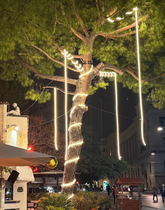LED vs. EL vs. Fiber Optic: A B2B Guide to Choosing the Right Lighting Technology for Your Next Project
Lighting has evolved into far more than mere illumination. In today’s competitive B2B landscape, lighting defines brand experiences, enhances safety, and brings creativity to life across architectural, retail, automotive, marine, and fashion applications.
Among the versatile technologies available, three stand out for their unique strengths:
• LED (Light Emitting Diode)
• EL (Electroluminescent) Lighting
• Fiber Optics (with a special focus on Laser Wire)
Understanding when and where to use each technology can mean the difference between a good design and a truly innovative solution. Here’s how these technologies compare — and where they excel.
________________________________________
Electroluminescent (EL) Lighting
Electroluminescent lighting creates a soft, uniform glow by passing an electric field through phosphor-based materials sandwiched between conductive layers. Unlike point-source LEDs, EL lights are surface emitters, which makes them ideal for applications requiring subtle, evenly distributed illumination.

Where EL Excels
Window Displays
• Perfect for attention-grabbing signage and accent lighting in retail settings.
• Excellent for illuminating logos, graphics, or large flat visuals with no visible hotspots.
Curved & Flat Panel Applications
• EL materials are flexible and thin, easily conforming to curves, contours, and flat surfaces.
• Ideal for integration into unique display geometries.
Low-Light Environments
• EL lighting performs best in dimly lit conditions where subtle glow is preferred over intense brightness.
Specialty Applications
• Automotive Wraps: Used to add illuminated branding or accents directly onto vehicle bodies, creating striking night-time effects.
• Safety Gear: Integrated into vests, jackets, or backpacks for visibility in dark environments.
• Fashion & Clothing: Enables designers to create light-infused garments, adding dynamic visual effects to fashion shows or performance wear.
• Marine & Aerospace Backlighting: EL panels provide low-profile, lightweight backlighting for cockpit panels, cabin signage, and instrument panels.
Limitations of EL
• Lower brightness levels than LEDs or Laser Wire, especially in bright ambient conditions.
• Limited color intensity and less vibrant colors compared to LEDs.
• Lifespan is shorter than LED, particularly under high voltage or continuous use.

________________________________________
Fiber Optics (Laser Wire Focused)
Traditional fiber optic lighting transmits light from a remote light source through optical fibers, offering excellent light placement flexibility. However, modern Laser Wire technology takes fiber optics further by integrating laser diodes for more intense, uniform illumination. Rather than a plastic optical core which tends to dissipate in brightness after a short distance, the glass core of Laser Wire extends its brightness over a much farther span, opening up the door of possibilities to a new realm of lighting applications.

Laser Wire typically measures under 1mm in diameter, making it exceptionally slim and suitable for precision applications.
Where Laser Wire Excels
Linear Lighting in Compact Spaces
• Delivers crisp, even light without hotspots.
• Ideal for accent lines, outlining architectural features, or integrated trim lighting.
Embedding in Materials
• Tiny diameter allows Laser Wire to be routed through woods, plastics, composites, and metals.
• Perfect for custom furniture, cabinetry, or automotive interior features.
Marine Applications (Yachts, Superyachts)
• Integrated into teak decks, handrails, or detailing for ambient nighttime effects.
• Saltwater-resistant and low maintenance.
Automotive Interiors
• Embedded into armrests, seats, door panels, and dashboard accents.
• Adds luxury feel and enhances cabin ambiance.
Retail Displays & Signage
• Creates visually striking outlines or accent lighting.
• Maintains ultra-slim profiles without visible light sources.
Wayfinding and Safety Lighting
• Used in architectural environments to highlight pathways, stairs, or emergency routes subtly yet effectively.
Advantages of Laser Wire Over Traditional Fiber Optics
• More uniform illumination along the fiber length.
• Higher brightness achievable in smaller diameters.
• Better color consistency and less light “fade” along the run.
Limitations of Laser Wire
• Higher initial cost than standard LED solutions.
• Limited throw distance; not intended for large area illumination.
• Requires precise installation and sometimes custom routing channels.

________________________________________
LED Lighting
Light Emitting Diodes have transformed modern lighting with their unparalleled efficiency, brightness, and color flexibility. They range from tiny indicator lights to powerful fixtures illuminating entire stadiums. In today's lighting world, LED's tend to be the gold standard among lighting applications because of its efficiency, wide range of uses, specific products to meet practical applications, and ability to meet the needs of nearly any project.

Where LEDs Excel
Broad Versatility
• From architectural façades to under-cabinet lighting, signage, and general illumination, LEDs fit nearly any lighting need.
High Brightness & Throw
• Suitable for applications requiring significant lumen output and visibility at distance.
Color Variety & Dynamic Effects
• Available in virtually any color, including RGB and tunable white for dynamic color-changing effects.
Long Lifespan & Low Maintenance
• Often rated for 50,000+ hours, significantly outlasting EL and even some fiber optic solutions.
Pixel-Free LED Solutions
A critical innovation in the LED space is Pixel-Free LED technology. Unlike traditional LED strips that show visible point sources (dots) along their length, Pixel-Free LEDs diffuse the light to create a seamless, uniform glow:
• Ideal for commercial and architectural installations demanding elegant, dot-free lines of light.
• Used in:
o Window displays
o Retail shelving and accent lighting
o Architectural coves and niches
o Outdoor pathways, stair risers, and backyard features
o Hospitality and entertainment venues
Pixel-Free LEDs maintain all the benefits of LED technology while elevating visual aesthetics by eliminating harsh “pixelation.”
Limitations of LEDs
• Standard LED strips can reveal “hotspots” without proper diffusion.
• Rigid LED boards can be less flexible for complex curves or tight-radius applications (where EL or Laser Wire might be better suited).
• Sometimes bulkier than ultra-slim Laser Wire solutions for embedded designs.

For more information on any of these technologies, or to see how they could be integrated into your next project, feel free to reach out. If you have a custom project that requires specific attention, please visit our Custom Lighting page.
- Choosing a selection results in a full page refresh.




